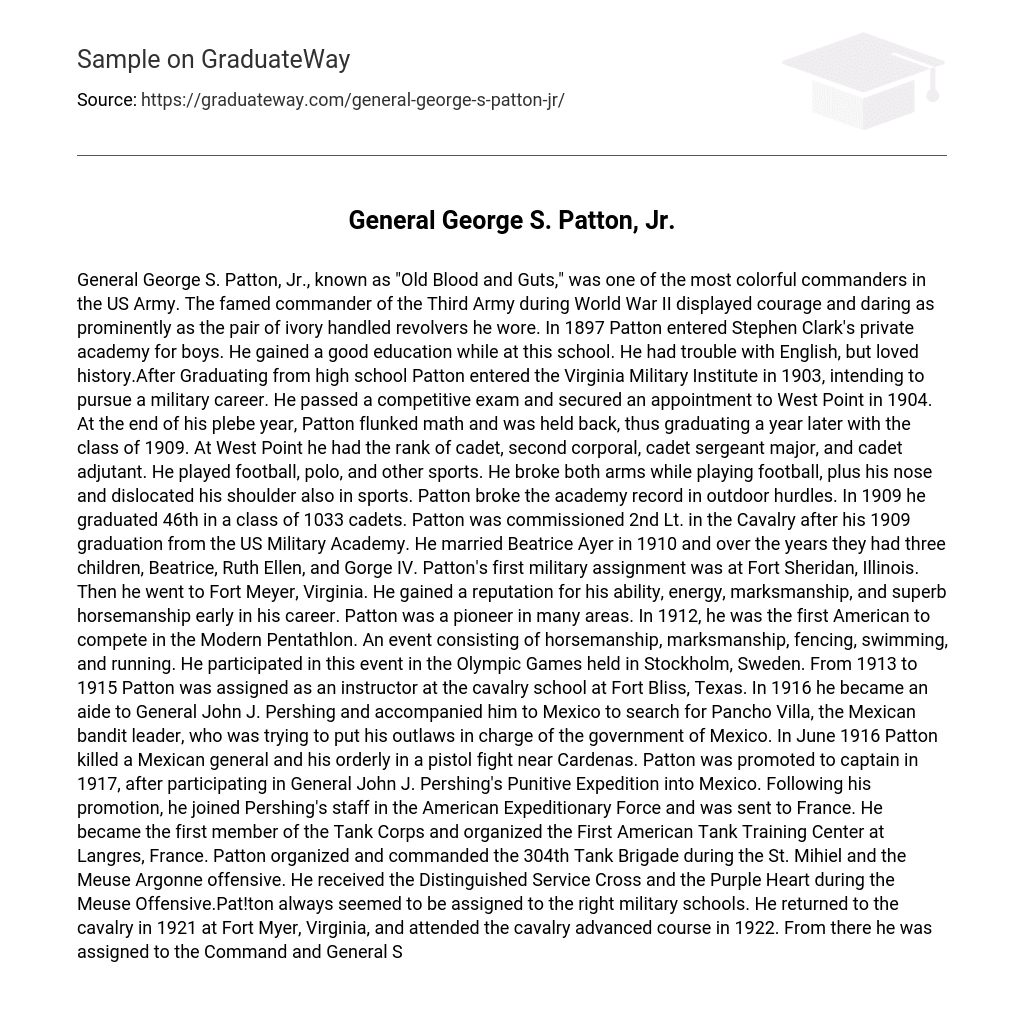Known as “Old Blood and Guts,” was one of the most colorful commanders in the US Army. The famed commander of the Third Army during World War II displayed courage and daring as prominently as the pair of ivory handled revolvers he wore. In 1897 Patton entered Stephen Clark’s private academy for boys. He gained a good education while at this school. He had trouble with English, but loved history.After Graduating from high school Patton entered the Virginia Military Institute in 1903, intending to pursue a military career. He passed a competitive exam and secured an appointment to West Point in 1904. At the end of his plebe year, Patton flunked math and was held back, thus graduating a year later with the class of 1909. At West Point he had the rank of cadet, second corporal, cadet sergeant major, and cadet adjutant.
He played football, polo, and other sports. He broke both arms while playing football, plus his nose and dislocated his shoulder also in sports. Patton broke the academy record in outdoor hurdles. In 1909 he graduated 46th in a class of 1033 cadets. Patton was commissioned 2nd Lt. in the Cavalry after his 1909 graduation from the US Military Academy. He married Beatrice Ayer in 1910 and over the years they had three children, Beatrice, Ruth Ellen, and Gorge IV. Patton’s first military assignment was at Fort Sheridan, Illinois. Then he went to Fort Meyer, Virginia. He gained a reputation for his ability, energy, marksmanship, and superb horsemanship early in his career. Patton was a pioneer in many areas. In 1912, he was the first American to compete in the Modern Pentathlon. An event consisting of horsemanship, marksmanship, fencing, swimming and running.
He participated in this event in the Olympic Games held in Stockholm, Sweden. From 1913 to 1915 Patton was assigned as an instructor at the cavalry school at Fort Bliss, Texas. In 1916 he became an aide to General John J. Pershing and accompanied him to Mexico to search for Pancho Villa, the Mexican bandit leader, who was trying to put his outlaws in charge of the government of Mexico. In June 1916 Patton killed a Mexican general and his orderly in a pistol fight near Cardenas. Patton was promoted to captain in 1917, after participating in General John J. Pershing’s Punitive Expedition into Mexico. Following his promotion, he joined Pershing’s staff in the American Expeditionary Force and was sent to France. He became the first member of the Tank Corps and organized the First American Tank Training Center at Langres, France.
Patton organized and commanded the 304th Tank Brigade during the St. Mihiel and the Meuse Argonne offensive. He received the Distinguished Service Cross and the Purple Heart during the Meuse Offensive.Pat!ton always seemed to be assigned to the right military schools. He returned to the cavalry in 1921 at Fort Myer, Virginia, and attended the cavalry advanced course in 1922. From there he was assigned to the Command and General Staff School at Fort Leavenworth, Kansas, where he graduated in 1923. He was then sent to the First Corps area in Boston. In 1924 he went to Hawaii on the General Staff and remained there until 1928. From 1928 through !935 he served in the office of the Chief of Cavalry, then took a course at the Army War College. Following these assignments he became an Executive Officer of the Third Cavalry at Fort Myer.
He was promoted to Major General in 1941.In the early years of World War II, Patton played a major role in the North Africa and Sicily Campaigns. In his Sicily champaign, July 10, 1943, he beat the British Commander Montgomery to Messina. This upset many people, because it was planned that Montgomery was to take Messina. But, he is best remembered for his command of the Third Army during its drive across France. The Third army pushed through the German defenses and captured thousands of prisoners before being forced to stop, due to a lack of logistical support, at the Seine and Meuse Rivers. Patton incurred unfavorable publicly for slapping a combat-exhausted soldier in a hospital, he later apologized for this incident. Even with this bad media Patton accomplished one of the most remarkable feats in military history in December 1944, when he quickly turned the Third Army northward to reinforce the Allied southern flank against the German attack in the Battle of the Bulge.
The Battle of the Bulge, or Battle of the Ardennes, fought from December 16, 1944 to January 31, 1945. This was Germany’s last major attempt to stop the allied invasion of Europe. The Germans were halted by the U.S. 1st and 3rd armies, the latter under General Patton forced the Germans to retreat. The Third Army’s 4th Armored Division, spearheaded by LT. Colonel Creighton Abrams’ 37th Tank Battalion, rescued and relieved the “Battered Bastards of Bastogne,” the 101st Airborne Division. It was not until 1945 that Patton was promoted to full General. After he was promoted WWII ended in Europ!e and he was assigned to command the Third Army occupation of Bavaria. Patton was fatally injured in an automobile accident near Mannhiem, Germany.





